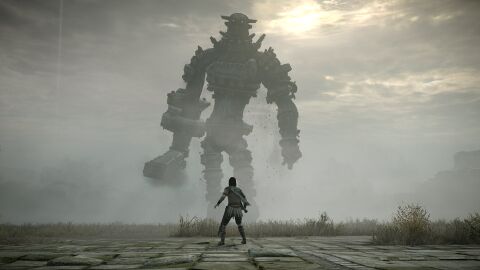Shadow of the Colossus
From GameLabWiki
A Colossus staring down the player-avatar Wanda
About the game
Shadow of the Colossus, released in Japan as Wanda and the Colossus, is an single player action-adventure game developed by SCE Japan Studio and Team Ico, and published by Sony Computer Entertainment for the PlayStation 2. The game was released in North America and Japan in October 2005 and PAL regions such as Europe in February 2006. It was directed by Fumito Ueda and developed at SCEI's International Production Studio 1, also known as Team Ico; the same development team responsible for the cult hit Ico, to which the game is considered a spiritual successor.
It can be best described as an action-adventure-game with puzzle-elements.
Shadow of the Colossus received almost universal acclaim upon its release and a cult-following during the following years, prompting the release of an HD-Version for the Playstation 3 alongside its progenitor Ico in the year 2011 and a complete remake for the PS4 in 2018. Thus it has been playable on every SONY home console since its release.
Much of the discourse around the game can strike one as downright esoteric at first, owed to the vague and simplistic nature of story and gameplay.
Narratologic segments such as cutscenes take up a very minimal ammount of the game and overall the total wordcount spoken remains fairly low. Colossuses gameplay remains simplistic as well. There are no level-progresssion or experience points in the game, no customizable items or collectibles. Gameplay can be easily broken up into „ride horse“, „climb“, “jump“ „shoot arrow“ and „stab“ and the last one could even be seen as a glorified quick time event. After one Colossus is killed you repeat the process 16 times.
Lastly, apart from the puzzle-like design of the colossi, the level design is pretty barren, covering mostly empty fields. Any real complexity in the overall play aspect is found at the intersection of all these mechanics at once. While the density of mechanics might be low, at ist largest, the player is in control of Wanda riding through the desert at breackneck speed following a huge stoneserpent, trying to somehow get on a tiny patch of climmable fur on its back.
Story and gameplay
Research relevant approaches
Narratology and Ludology
Ludology (Huizinga/Jasper Juul/ Robert Callois) The Discipline that studies the Act of playing a game. The Field of Ludology includes researchers such as Johann Huizinga the father of Ludology with his 1955 work Homo ludens, in which he first emphasized playing as part of individual- and groupdevelopment. Games should be understood as systems in which players engage in artificial conflict, defined by specific rules, which eventually result in a quantifiable outcome.
Narratology
Many ludologists have argued against the use of narratlogic explanations when it comes to games, as they see them as inherently non-narratologic or at least their narratives being out of the focus of research studying play. They aren`t movies or books making them a new form of text and such, subject of ludology (Juul, Aarseth). Frasca argues, however that if a narrative is included in a game, studying the NARRATION (not narrative) should nevertheless be part of studying the game. Computer games, according to Huizinga, share many key aspects of representation with more traditional mediums such as movies or books. Despite this fact, they are deserving of its own approach, which is owed to a few major differences, including its unique relationship with the recipient. Games "read" their player and test their participation by presenting them with roadblocks in form of gameplay-challenges which hinder progression. As such they present a unique type of text, which is read, but also reacts and reads the reader.
Semiology in games
Shadow of the Colossus and its Hypertext
Vague, nondescriptive plots such as the one in colossus leave much up to player-imagination. This, coupled with the iconographic power of the Colossi, manages to create a strong metaphorical framework, which has been adapted and used in different works of media. As a hugely popular game, Shadow of the Colossus, its themes of intense loneliness produced by the barrenly minimal complexity of gameworld and design, and the semiotic impact of its titular Colossi caught the attention of filmmaker-duo Mike and Jack Binder. The two brothers implemented the game into the story of their 2007 film Reign Over Me, starring Adam Sandler as Alan Johnson, a father who lost his family in the 2001 attack on the World Trade Center. "You could see where someone who was dealing with 9/11 would be engrossed by a giant that keeps collapsing over and over again," - Mike Binder, 2007
Alan obsessively seeks catharsis in the iconographic relief of making the colossus collapse himself and while he is in control of the situation. Basically nothing about the games story, but the fact, that a small man makes hunt on huge colossi and has to bring them down, is shown in the film. Yet, many aspects of why Shadow of the Colossus might have an appeal on Alan are very clearly communicated in about two minutes. As Colossus works in the film, it is a short, affectionate piece, communicating not only the emotional state of a character, but also the role of video games as a coping mechanism for someone who might have suffered a tragedy.
As such, it metanarratively points out ludic qualities and metanarrative potentials about the game and games in general. The narratolgical choice of Colossus as the game the depressed Alan obsesses over, becomes even more apparent, when you consider the games narration of a person willing to risk everything and fight against an insurmountable task, to ressurect, a deceased loved one.
The game in the film also represents a turning point as it aids in the reconnection of two characters. “They bond through games and lose themselves in them, only to find themselves again. They enjoy the simple act of play.“

